Structural Resistance of Reinforced Concrete Buildings in Areas of Moderate Seismicity and Assessment of Strategies for Structural Improvement
Abstract
:1. Introduction
2. Background
3. Materials and Methods
3.1. Methodology Outline
3.2. Representative Earthquake
3.3. Representative Buildings
4. Analysis
4.1. Main Frame Modelling
4.2. Infill Wall Modelling
5. Results
5.1. Non-Linear Static (Pushover) Analysis
5.2. Dynamic Analysis
6. Conclusions
Acknowledgments
Author Contributions
Conflicts of Interest
References
- Milsom, J. The Vrancea seismic zone and its analogue in the Banda Arc, eastern Indonesia. Tectonophysics 2005, 410, 325–336. [Google Scholar] [CrossRef]
- Chiarabba, C.; Amato, A.; Anselmi, M.; Baccheschi, P.; Bianchi, I.; Cattaneo, M.; Cecere, G.; Chiaraluce, L.; Ciaccio, M.G.; de Gori, P. The 2009 L’Aquila (central Italy) M(W)6.3 earthquake: Main shock and aftershocks. Geophys. J. Int. 2009, 36, L18308. [Google Scholar]
- Gigantesco, A.; Mirante, N.; Granchelli, C.; Diodati, G.; Cofini, V.; Mancini, C.; Carbonelli, A.; Tarolla, E.; Minardi, V.; Salmaso, S. Psychopathological chronic sequelae of the 2009 earthquake in L’Aquila, Italy. J. Affect. Disord. 2013, 148, 265–271. [Google Scholar] [CrossRef] [PubMed]
- Abolmasov, B.; Jovanovski, M.; Feri, P.; Mihali, S. Losses due to historical earthquakes in the Balkan region: Overview of publicly available data. Geofizika 2011, 28, 161–181. [Google Scholar]
- Escobedo, A. Damage assessment on building structures subjected to the recent near-fault earthquake in Lorca (Spain). In Proceedings of the 15th World Conference On Earthquake Engineering, Lisbon, Portugal, 24–28 September 2012. [Google Scholar]
- López-Comino, J.-A.; de Lis Mancnilla, F.; Morales, J.; Stich, D. Rupture directivity of the 2011, Mw 5.2 Lorca earthquake (Spain). Geophys. Res. Lett. 2012, 39. [Google Scholar] [CrossRef]
- European Committee for Standardization. Eurocode 8: Design of Structures for Earthquake Resistance—Part 1: General Rules, Seismic Actions and Rules for Buildings; European Committee for Standardization: Brussels, Belgium, 2004. [Google Scholar]
- López-López, A.; Tomás, A.; Sánchez-Olivares, G. Behaviour of reinforced concrete rectangular sections based on tests complying with seismic construction requirements. Struct. Concr. 2016, 17, 656–667. [Google Scholar] [CrossRef]
- López-López, A.; Tomás, A.; Sánchez-Olivares, G. Influence of adjusted models of plastic hinges in nonlinear behaviour of reinforced concrete buildings. Eng. Struct. 2016, 124, 245–257. [Google Scholar] [CrossRef]
- López-Almansa, F.; Domínguez, D.; Benavent-Climent, A. Vulnerability analysis of RC buildings with wide beams located in moderate seismicity regions. Eng. Struct. 2013, 46, 687–702. [Google Scholar] [CrossRef] [Green Version]
- Dominguez, D.; Almansa, F.L.; Climent, A.B. Comportamiento, para el terremoto de Lorca de 11-05-2011, de edificios de vigas planas proyectados sin tener en cuenta la acción sísmica. Inf. Constr. 2014, 66. (In Spanish) [Google Scholar] [CrossRef] [Green Version]
- Alam, N.; Alam, M.S.; Tesfamariam, S. Buildings’ seismic vulnerability assessment methods: A comparative study. Nat. Hazards 2012, 62, 405–424. [Google Scholar] [CrossRef]
- Calvi, G.M.; Pinho, R.; Magenes, G.; Bommer, J.J.; Crowley, H. Development of seismic vulnerability assessment methodologies over the past 30 years. Earthquake 2006, 43, 75–104. [Google Scholar]
- Freeman, S.A.; Nicoletti, J.P.; Tyrrell, J.B. Evaluations of existing buildings for seismic risk—A case study of Puget Sound naval shipyard, Bremerton, Washington. In Proceedings of the US National Conference on Earthquake Engineering, Ann Arbor, MI, USA, 18–20 June 1975; pp. 113–122. [Google Scholar]
- Comartin, C.D.; Rojahn, C.; Niewiarowski, R.W. Seismic Evaluation and Retrofit of Concrete Buildings; California Seismic Safety Commission: Sacramento, CA, USA, 1996; ATC-40.
- Calvi, G.M.; Priestley, N. Design and Assessment of Bridges. In Advanced Earthquake Engineering Analysis; Pecker, A., Ed.; Springer: Berlin, Germany, 2007; pp. 155–179. [Google Scholar]
- Fajfar, P.; Fischinger, M. N2—A method for non-linear seismic analysis of regular buildings. In Proceedings of the 9th World Conference on Earthquake Engineering, Tokyo, Japan, 2–9 August 1988; pp. 111–116. [Google Scholar]
- Churilov, S.; Dumova-Jovanoska, E. In-plane shear behaviour of unreinforced and jacketed brick masonry walls. Soil Dyn. Earthq. Eng. 2013, 50, 85–105. [Google Scholar] [CrossRef]
- Ghosh, S.; Datta, D.; Katakdhond, A.A. Estimation of the Park-Ang damage index for planar multi-storey frames using equivalent single-degree systems. Eng. Struct. 2011, 33, 2509–2524. [Google Scholar] [CrossRef]
- Rossetto, T.; Elnashai, A. A new analytical procedure for the derivation of displacement-based vulnerability curves for populations of RC structures. Eng. Struct. 2005, 27, 397–409. [Google Scholar] [CrossRef]
- Haldar, A.; Mahadevan, S. Probability, Reliability, and Statistical Methods in Engineering Design; John Wiley: Hoboken, NJ, USA, 2000. [Google Scholar]
- Kroese, D.P.; Brereton, T.; Taimre, T.; Botev, Z.I. Why the Monte Carlo method is so important today. Wiley Interdiscip. Rev. Comput. Stat. 2014, 6, 386–392. [Google Scholar] [CrossRef]
- Casas, J.R.; Wisniewski, D.F.; Cervenka, J.; Plos, M. Safety and Probabilistic Modelling: Background Document D4.4; Sustainable Bridges–VI Framework Program: Brussels, Belgium, 2007. [Google Scholar]
- Vargas, Y.F.; Pujades, L.G.; Barbat, A.H.; Hurtado, J.E. Incremental dynamic analysis and pushover analysis. A probabilistic comparison. In Computational Methods in Stochastic Dynamics; Springer: Berlin, Germany, 2011. [Google Scholar]
- Vielma-Perez, J.C.; Barbat, A.H.; Oller, S. Curvas de fragilidad y matrices de probabilidad de daño de edificios de concreto armado con ductilidad limitada. Rev. Desastr. Nat. Accid. Infraestruct. Civ. 2007, 7, 273–286. (In Spanish) [Google Scholar]
- Applied Technology Council. Improvement of Nonlinear Static Seismic Analysis Procedures; ATC-55 Project; Federal Emergency Management Agency: Washington, DC, USA, 2005.
- Marques, R.; Lourenço, P.B. Unreinforced and confined masonry buildings in seismic regions: Validation of macro-element models and cost analysis. Eng. Struct. 2014, 64, 52–67. [Google Scholar] [CrossRef] [Green Version]
- Domínguez, D. Seismic vulnerability analysis of wide-beam buildings in Spain. In Proceedings of the 15th World Conference on Earthquake Engineering, Lisboa, Portugal, 24–28 September 2012. [Google Scholar]
- Benavent-Climent, A.; Cahís, X.; Vico, J.M. Interior wide beam-column connections in existing RC frames subjected to lateral earthquake loading. Bull. Earthq. Eng. 2009, 8, 401–420. [Google Scholar] [CrossRef]
- Barbat, A.H.; Pujades, L.G.; Lantada, N. Performance of buildings under earthquakes in Barcelona, Spain. Comput. Civ. Infrastruct. Eng. 2006, 21, 573–593. [Google Scholar] [CrossRef]
- Barbat, A.H.; Carreño, M.L.; Pujades, L.G.; Lantada, N.; Cardona, O.D.; Marulanda, M.C. Seismic vulnerability and risk evaluation methods for urban areas. A review with application to a pilot area. Struct. Infrastruct. Eng. 2010, 6, 17–38. [Google Scholar] [CrossRef]
- Guéguen, P.; Michel, C.; LeCorre, L. A simplified approach for vulnerability assessment in moderate-to-low seismic hazard regions: Application to Grenoble (France). Bull. Earthq. Eng. 2007, 5, 467–490. [Google Scholar] [CrossRef]
- Michel, C.; Guéguen, P.; Lestuzzi, P.; Bard, P.-Y. Comparison between seismic vulnerability models and experimental dynamic properties of existing buildings in France. Bull. Earthq. Eng. 2010, 8, 1295–1307. [Google Scholar] [CrossRef]
- Mucciarelli, M.; Contri, P.; Monachesi, G.; Calvano, G.; Gallipoli, M. An empirical method to assess the seismic vulnerability of existing buildings using the HVSR technique. Pure Appl. Geophys. 2002, 158, 2635–2647. [Google Scholar] [CrossRef]
- Dolce, M.; Kappos, A.; Masi, A.; Penelis, G.; Vona, M. Vulnerability assessment and earthquake damage scenarios of the building stock of Potenza (Southern Italy) using Italian and Greek methodologies. Eng. Struct. 2006, 28, 357–371. [Google Scholar] [CrossRef]
- Manfredi, G. Evaluation of seismic energy demand. Earthq. Eng. Struct. Dyn. 2001, 30, 485–499. [Google Scholar] [CrossRef]
- Ministerio de Fomento. Instrucción de Hormigón Estructural EHE 08; Ministerio de Fomento: Madrid, Spain, 2008. (In Spanish)
- Ministerio de Vivienda. Documento básico. Código técnico de la edificación. Acciones en la edificación, DB-CTE-SE-AE; Ministerio de Vivienda: Madrid, Spain, 2006. (In Spanish)
- De Luca, F.; Verderame, G.M.; Gómez-Martínez, F.; Pérez-García, A. The structural role played by masonry infills on RC building performances after the 2011 Lorca, Spain, earthquake. Bull. Earthq. Eng. 2013, 12, 1999–2026. [Google Scholar] [CrossRef] [Green Version]
- SeismoSoft. SeismoStruct—A Computer Program for Static and Dynamic Nonlinear Analysis of Framed Structures. Available online: http://www.seismosoft.com (accessed on 30 December 2016).
- Zieenkiewicz, O.C.; Taylor, R.L. The Finite Element Method; Elsevier: Amsterdam, The Netherlands, 1993. [Google Scholar]
- Scott, M.H.; Fenves, G.L. Plastic hinge integration methods for force-based beam–column elements. J. Struct. Eng. 2006, 132, 244–252. [Google Scholar] [CrossRef]
- Mander, J.B.; Priestley, M.J.N.; Park, R. Theoretical stress strain model for confined concrete. J. Struct. Eng. 1988, 114, 1804–1825. [Google Scholar] [CrossRef]
- Ferrara, E.; Bosco, M.; Ghersi, A.; Marino, E.M.; Rossi, P.P. Improvement of the model proposed by Menegotto and Pinto for steel. Eng. Struct. 2016, 124, 442–456. [Google Scholar]
- Spacone, E.; Filippou, F. Flexibility-based frame models for nonlinear dynamic analysis. In Proceedings of the 11th World Conference on Earthquake Engineering, Acapulco, Mexico, 23–28 June 1996. [Google Scholar]
- Scott, M.H.; Fenves, G.L.; McKenna, F.; Filippou, F.C. Software patterns for nonlinear beam-column models. J. Struct. Eng. 2008, 134, 562–571. [Google Scholar] [CrossRef]
- Belletti, B.; Damoni, C.; Hendriks, M.; de Boer, A. Analytical and numerical evaluation of the design shear resistance of reinforced concrete slabs. Struct. Concr. 2014, 15, 317–330. [Google Scholar] [CrossRef]
- Newmark, N.M. A method of computation for structural dynamics. J. Eng. Mech. Div. 1959, 85, 67–94. [Google Scholar]
- Gavin, H. Numerical Integration for Structural Dynamics; Department of Civil and Environmental Engineering, Duke University: Durham, NC, USA, 2001. [Google Scholar]
- Mergos, P.E.; Kappos, A.J. Estimating fixed-end rotations of reinforced concrete members at yielding and ultimate. Struct. Concr. 2015, 16, 537–545. [Google Scholar] [CrossRef]
- Crisafulli, F.J.; Carr, A.J.; Park, R. Experimental response of framed masonry structures designed with new reinforcing details. Bull. N. Z. Soc. Earthq. Eng. 2005, 38, 19–32. [Google Scholar]
- Priestley, M.J.N.; Grant, D.N.; Blandon, C.A. Direct displacement-based seismic design. In Proceedings of the 2005 New Zealand Society for Earthquake Engineering Conference, Wairakei, New Zealand, 11–13 March 2005. [Google Scholar]
- European Committee for Standardization. Eurocode 6: Design of Masonry Structures; European Committee for Standardization: Brussels, Belgium, 2005. [Google Scholar]
- Mostafaei, H.; Kabeyasawa, T. Masonry walls on the seismic response of reinforced concrete buildings subjected to the 2003 Bam earthquake strong motion: A case study of Bam telephone center. Earthq. Res. Inst. Univ. 2004, 79, 133–156. [Google Scholar]
- Priestley, M.J.N.; Paulay, T. Seismic Design of Reinforced Concrete and Masonry Buildings; Wiley: Hoboken, NJ, USA, 1992. [Google Scholar]
- American Concrete Institute. Building Code Requirements for Masonry Structures and Specifications for Masonry Structures; American Concrete Institute: Farmington Hills, MI, USA, 1988. [Google Scholar]
- Madia, F.C.A.; Parsekian, G.A. Modeling a reinforced concrete building frame with infill. In Proceedings of the 11th North American Masonry Conference, University of Minnesota, Minneapolis, MN, USA, 5–8 June 2011. [Google Scholar]
- Filippou, F.C.; Ambrisi, A.D.; Issa, A. Nonlinear Static and Dynamic Analysis of Reinforced Concrete Subassemblages; Earthquake Engineering Research Center, College of Engineering, University of California: Oakland, CS, USA, 1992. [Google Scholar]
- Magnusson, J.; Hallgren, M.; Ansell, A. Shear in concrete structures subjected to dynamic loads. Struct. Concr. 2014, 15, 55–65. [Google Scholar] [CrossRef]
- Spiliopoulos, K.V.; Lykidis, G.C. An efficient three-dimensional solid finite element dynamic analysis of reinforced concrete structures. Earthq. Eng. Struct. Dyn. 2006, 35, 137–157. [Google Scholar] [CrossRef]

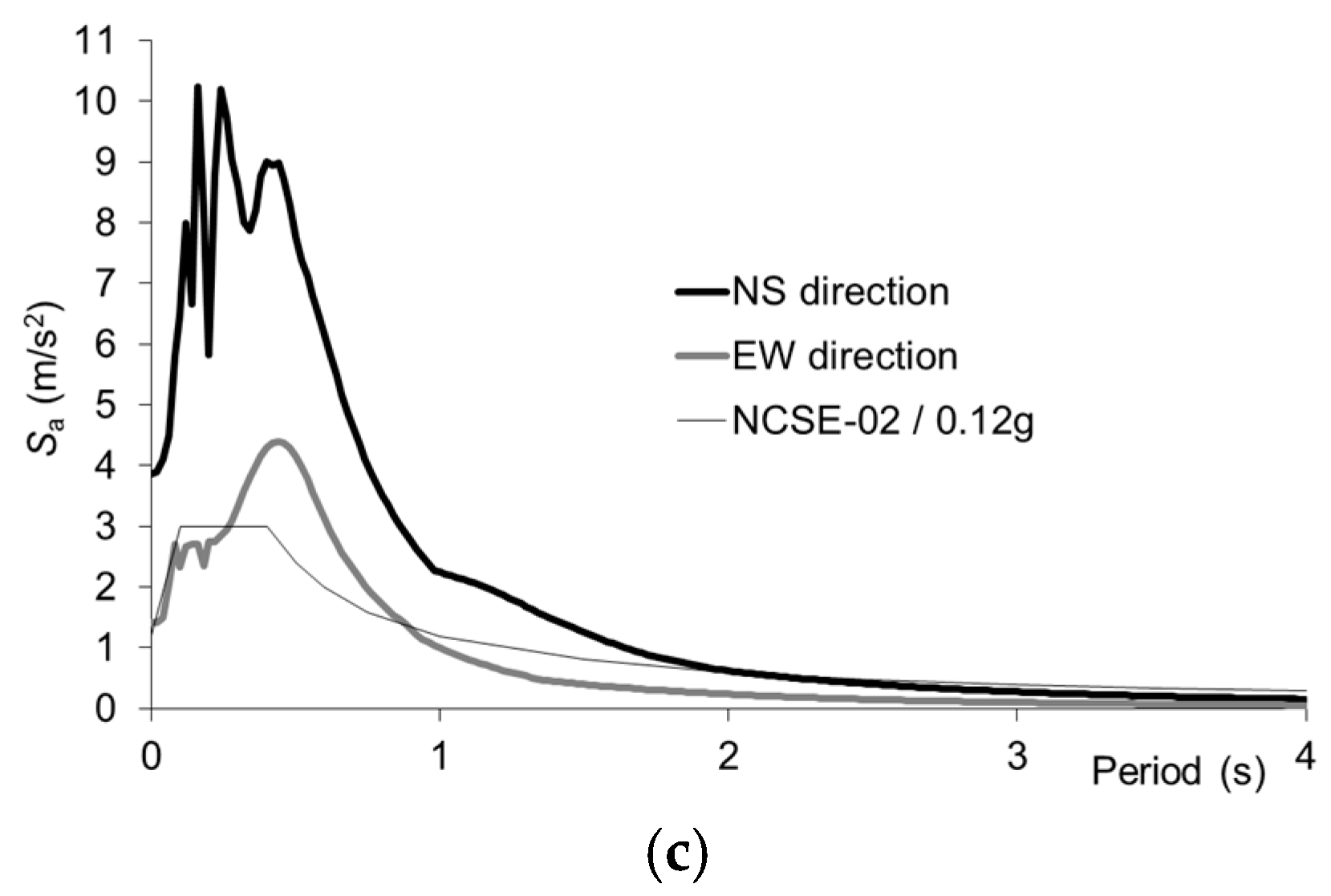
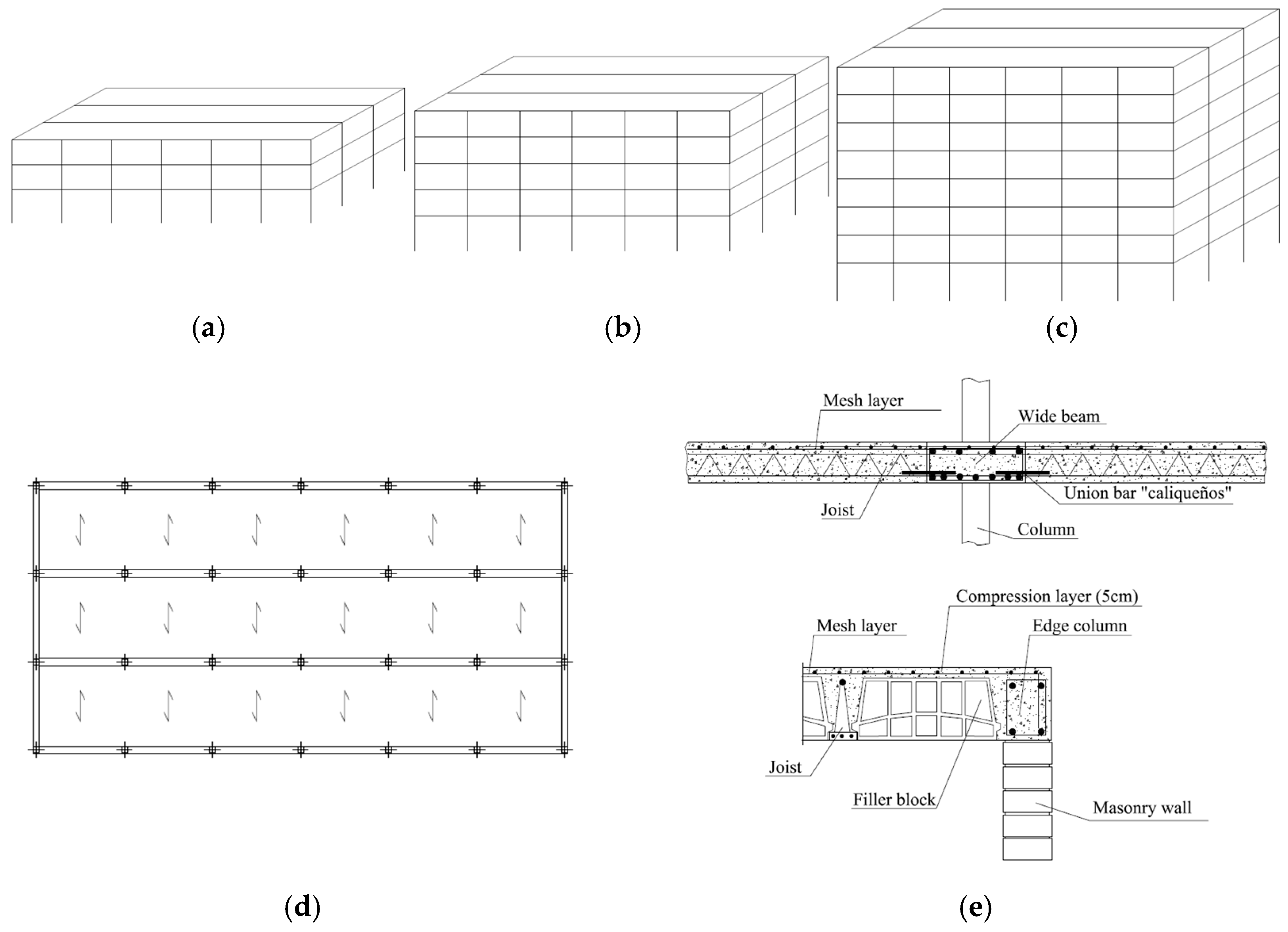

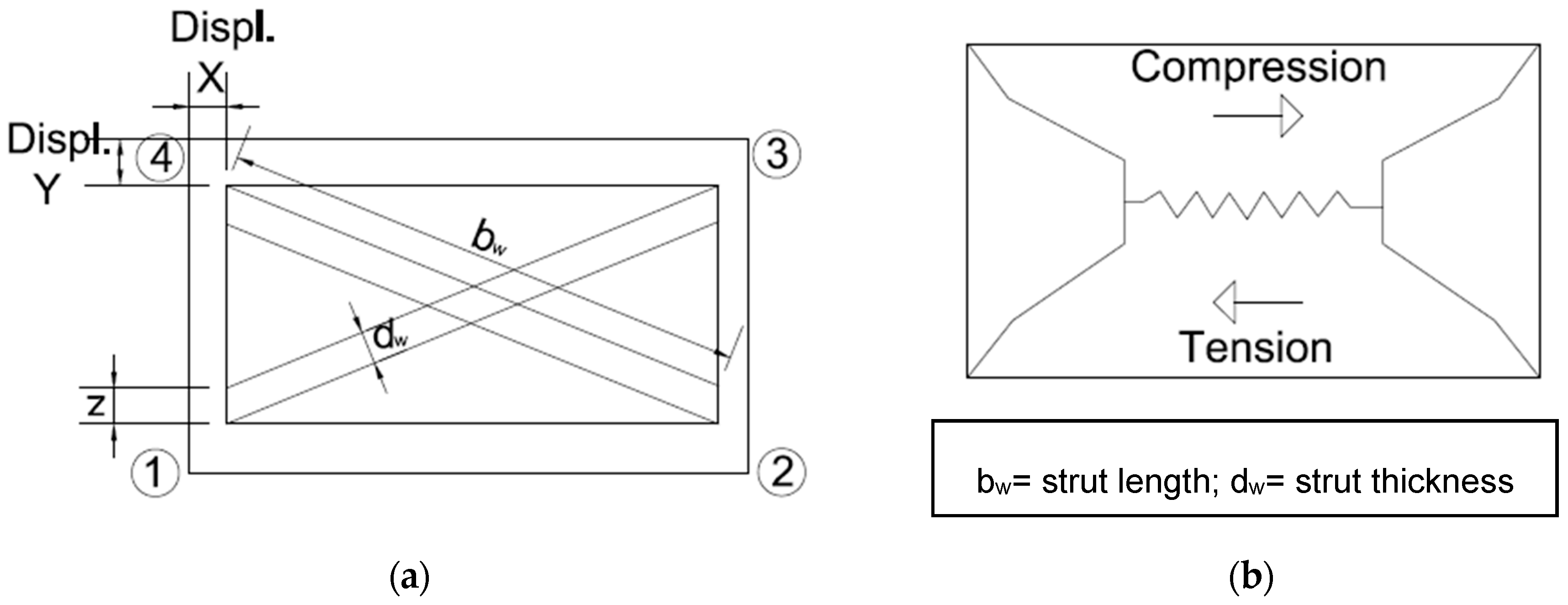
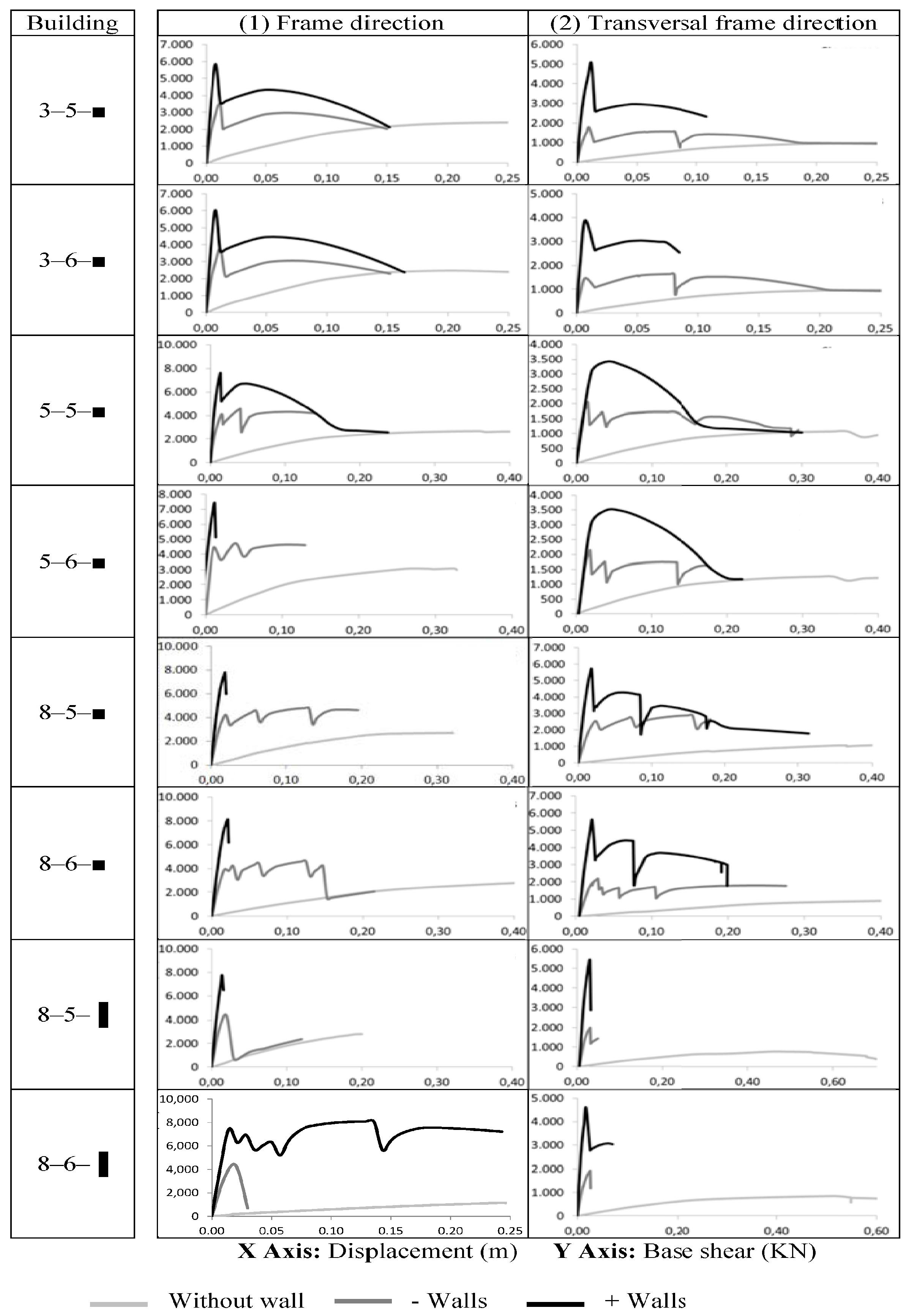

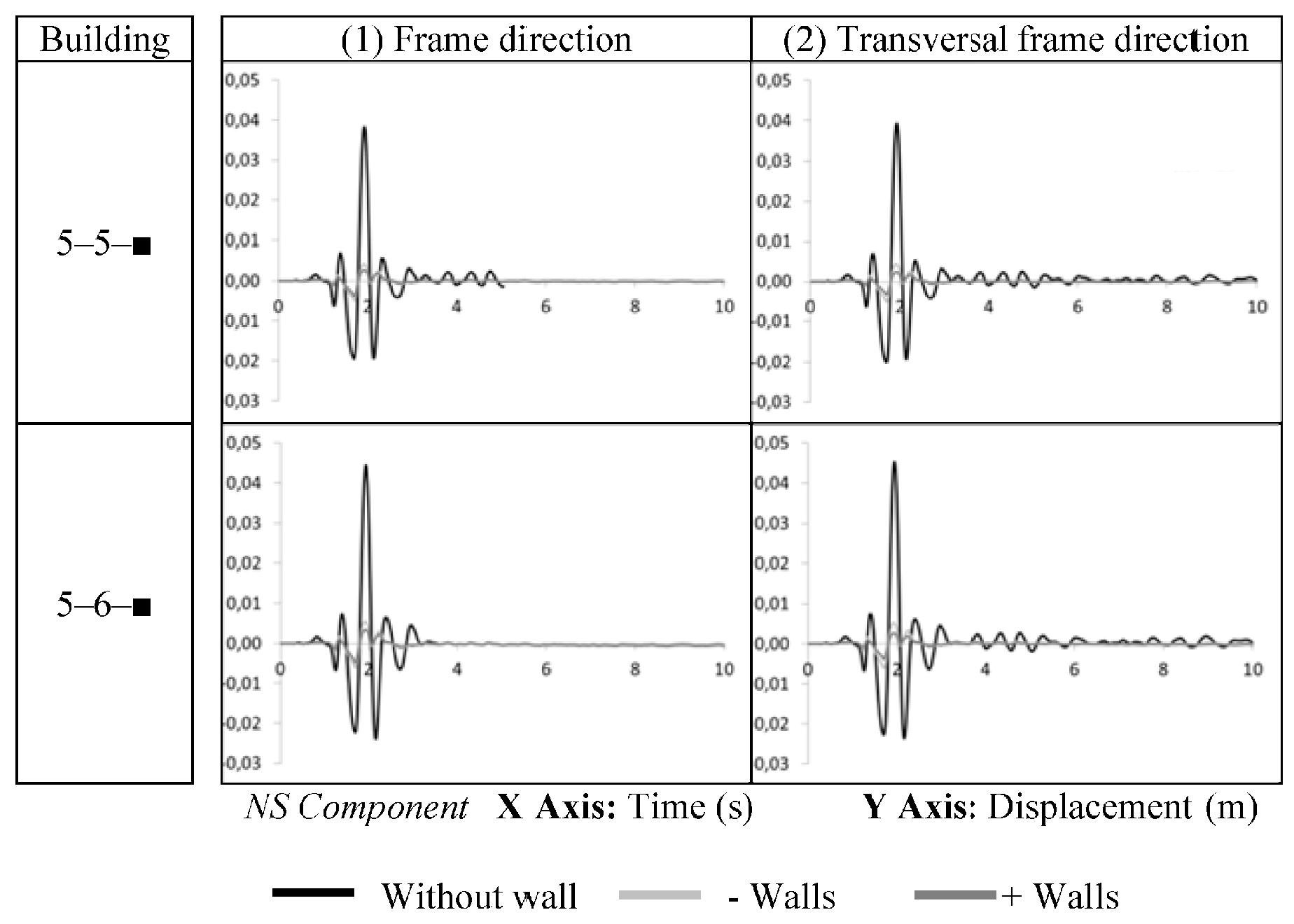

| Building | Height (m) | Columns Ground Floor (cm2) | Column Upper Floor (cm2) | Wide Beams (cm2) | Weight (kN) | Fundamental Period (s) (Frame Direction/in the Transversal Frame Dir.) | ||
|---|---|---|---|---|---|---|---|---|
| “Without Walls” | “−Walls” | “+Walls” | ||||||
| 3–5–■ | 10 | 35 × 35 | 35 × 35 | 40 × 30 | 11725 | 1.041/0.914 | 0.211/0.209 | 0.140/0.139 |
| 3–6–■ | 10 | 35 × 35 | 35 × 35 | 40 × 35 | 14170 | 1.162/1.016 | 0.232/0.230 | 0.153/0.153 |
| 5–5–■ | 16 | 45 × 45 | 35 × 35 | 40 × 30 | 19542 | 1.551/1.376 | 0.342/0.340 | 0.228/0.227 |
| 5–6–■ | 16 | 45 × 45 | 35 × 35 | 40 × 35 | 23617 | 1.731/1.534 | 0.377/0.375 | 0.250/0.249 |
| 8–5–■ | 25 | 55 × 55 | 35 × 35 | 40 × 30 | 31267 | 3.108/3.071 | 0.547/0.546 | 0.361/0.361 |
| 8–6–■ | 25 | 55 × 55 | 35 × 35 | 40 × 35 | 37787 | 3.576/3.446 | 0.602/0.601 | 0.397/0.397 |
| 8–5–▐ | 25 | 80 × 30 | 40 × 30 | 40 × 30 | 29704 | 4.927/1.845 | 0.538/0.520 | 0.354/0.348 |
| 8–6–▐ | 25 | 80 × 30 | 40 × 30 | 40 × 35 | 35898 | 5.481/2.073 | 0.592/0.572 | 0.389/0.383 |
© 2017 by the authors. Licensee MDPI, Basel, Switzerland. This article is an open access article distributed under the terms and conditions of the Creative Commons Attribution (CC BY) license (http://creativecommons.org/licenses/by/4.0/).
Share and Cite
Dominguez-Santos, D.; Ballesteros-Perez, P.; Mora-Melia, D. Structural Resistance of Reinforced Concrete Buildings in Areas of Moderate Seismicity and Assessment of Strategies for Structural Improvement. Buildings 2017, 7, 89. https://doi.org/10.3390/buildings7040089
Dominguez-Santos D, Ballesteros-Perez P, Mora-Melia D. Structural Resistance of Reinforced Concrete Buildings in Areas of Moderate Seismicity and Assessment of Strategies for Structural Improvement. Buildings. 2017; 7(4):89. https://doi.org/10.3390/buildings7040089
Chicago/Turabian StyleDominguez-Santos, David, Pablo Ballesteros-Perez, and Daniel Mora-Melia. 2017. "Structural Resistance of Reinforced Concrete Buildings in Areas of Moderate Seismicity and Assessment of Strategies for Structural Improvement" Buildings 7, no. 4: 89. https://doi.org/10.3390/buildings7040089





